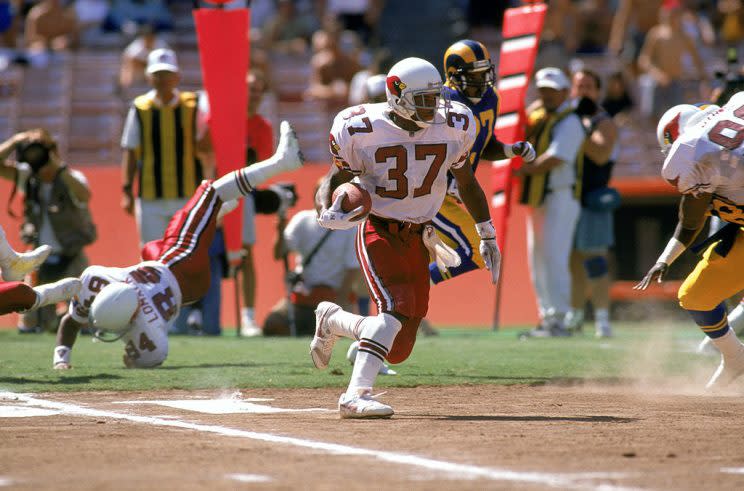PPR fantasy scoring is a relic. Let's try new things

Back in the day, we considered any fantasy manager a heretic if they didn’t draft running backs in the first, second and third rounds. RB hoarding was an entirely noncontroversial practice. Go find an ancient draft board if you don’t believe me. Maybe you weren’t the guy who went James Stewart-Duce Staley-Michael Pittman at the top, but someone did it. The opening rounds of any draft became a thoughtless recitation of running backs.
It was a bleak and terrible time. But our draft habits reflected the NFL’s reliance on every-down workhorse runners, guys who routinely handled 320-plus touches per season. Back then, it seemed impossible to win a fantasy league without a 1400-yard, 16-touchdown running back on your roster. Receivers and tight ends were more like decorations for a fantasy lineup.
As a way to end the tyranny of RB-heavy drafting, point-per-reception scoring (PPR) began to boom. It was a patch for a fantasy bug, and it worked more or less as intended. PPR increased the value of wide receivers and tight ends relative to a certain sort of running back; the T.J. Duckett-types became less appealing. The early rounds of PPR drafts definitely contained more positional diversity, a welcome change.
[Fantasy Football is open! Sign up now and start winning season early]
Somewhere along the way, a weird sort of PPR snobbery took hold — particularly among fantasy experts. Hardcore zealots emerged. They told us, among other things, that PPR was a smarter way to play, that it better represented the tendencies of a changing game by rewarding a critical skill. And we all played along, reshuffling cheat sheets, building rosters around the exquisite skills of Marty Booker and Larry Centers.
But here’s the thing: Within the context of an actual NFL game, a 5-yard reception is not substantially more valuable than a 5-yard run. No reasonable person would argue that a catch for no-gain should be scored the same in fantasy as a 10-yard rush (or 5, or 3). Receptions have no special meaning in reality, beyond the yards they generate. This seems fairly obvious.
So while we may have enjoyed the impact PPR scoring had on draft boards, we’d begun awarding points for a common event with no inherent value.
Oddly enough, as PPR scoring became more widespread in fantasy, offensive strategy in the NFL shifted in a way that devalued running backs. Committee arrangements became the norm. Passing stats surged. Before long, the game’s best receivers were routinely finishing among the league leaders in scrimmage yards.

Back in 1998, for example, the NFL produced only two 4000-yard passers, Brett Favre (4212) and Steve Young (4170). Eleven running backs finished with 300 or more carries that season, and Jamal Anderson handled 410. These were the NFL’s leaders in scrimmage yards in ’98:
1. Marshall Faulk, 2227
2. Terrell Davis, 2225
3. Jamal Anderson, 2165
4. Garrison Hearst, 2105
5. Barry Sanders, 1780
6. Curtis Martin, 1652
7. Fred Taylor, 1644
8. Ricky Watters, 1612
9. Eddie George, 1604
10. Emmitt Smith, 1507
Nothin’ but running backs. Four of the next five names on the leader board were RBs as well: Duce Staley, Robert Smith, Robert Edwards and Warrick Dunn. Antonio Freeman was the only receiver to crack the top-15. In that sort of statistical environment, it’s easy to understand why so many fantasy owners adopted PPR scoring.
Fifteen years later, however, things had changed. In 2013, nine different QBs exceeded Favre’s passing total from ’98. Peyton Manning and Drew Brees each topped 5000 yards. Only two running backs reached 300 carries, LeSean McCoy (314) and Marshawn Lynch (301). Four receivers cracked the NFL’s top-10 in scrimmage yards — Josh Gordon, Alshon Jeffery, Antonio Brown and Calvin Johnson — and a dozen finished among the top-25.
Today, in standard scoring leagues, you’d be a fool to ignore the game’s elite receivers in the opening rounds. No one does it. The NFL has evolved in a way that neatly addressed the primary concerns of PPR’s early advocates. PPR, essentially, is a relic.
Yet despite PPR’s strange scoring equivalencies, it continues to thrive as a custom league setting. If you’re good with that … well, OK. Cool. Who am I to tell you how to live your fantasy life? Do your thing. Play whatever fantasy variant you like most. Plenty of managers like to score for all sorts of minor in-game occurrences — completions, carries, receptions — simply because points are fun. Yay, points.
Really, as long as you aren’t one of the smug PPRists who insist that the rest of us are doing it wrong, I’ve got no beef with you.
I am, however, going to offer a recommendation to fantasy commissioners who are starting new leagues — and to commishes who’ve been playing PPR, but would prefer to only reward stats with real-world value. This year, set up a league that awards points for first downs (PPFD). Unlike receptions, first downs are unambiguously important in-game events. If you like, you can assign different fantasy values to rushing and receiving first downs, so as to preserve some special (if unneeded) scoring edge for WRs and TEs.
I’m involved in a league that uses these settings…

…and the result is a scoring system in which 14 wide receivers ranked among the top-30 flexes last season, with six among the top-15. (For the record, none of those 14 receivers were PPR specialists Jarvis Landry, Julian Edelman or Golden Tate.) I’ve found this to be a decent compromise format for those breaking the PPR habit. First down scoring won’t interfere with PPR’s original objective — positional variety among the top scorers — and it doesn’t grossly exaggerate the value of, say, a 6-yard checkdown on third-and-13.
Three years ago, 4for4‘s John Paulsen wrote an exhaustive review of PPR’s goals and shortcomings, and I’d encourage you to check it out if you’re waffling on 2017 league settings. John and I have discussed scoring preferences more than once, on multiple platforms, and we’re fairly well aligned.
Again, I’m not here to dissuade anyone from playing a fantasy format they happen to enjoy. Renew those PPR leagues, people. But please keep in mind that you have many custom scoring settings to choose from — a full menu of offensive and defensive options. (Tackles for loss? Got it. Three and outs? Got it.) You aren’t limited to merely PPR and standard. When launching a new league, consider giving PPFD scoring a test drive. If nothing else, I can pretty much guarantee it will change the way you experience all future third-and-short scenarios.
Follow the Yahoo crew on Twitter: Andy Behrens, Dalton Del Don, Brad Evans, Brandon Funston, Liz Loza, Scott Pianowski and Tank Williams


